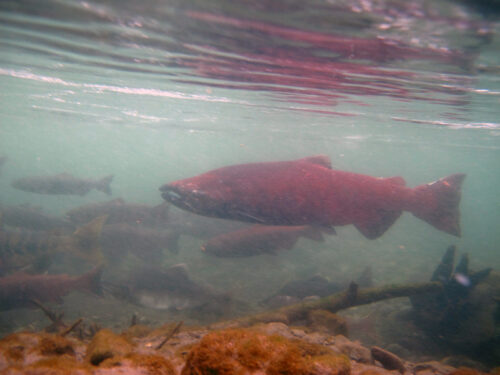
SalmonState On Stopping Bycatch Trawl In ‘Little-Known’ Prince William Sound Fishery
The following press release is courtesy of SalmonState:

Board of Fisheries could stop trawl bycatch in little-known Prince William Sound trawl fishery
The Alaska State Board of Fisheries this week will consider four proposals that would eliminate or reduce bycatch in the Prince William Sound “midwater” trawl fishery, which has zero observers and regularly bycatches bottom-dwelling species, potentially violating state law
DECEMBER 9, 2024
CORDOVA, ALASKA—The Alaska State Board of Fisheries is this week set to consider four proposals that would reduce or eliminate bycatch in Alaska’s only state-managed pollock pelagic trawl fishery, which takes place from January 20 through March 31 in Prince William Sound. The fishery has zero observer coverage and while supposedly “midwater,” trawlers regularly bycatch bottom-dwelling species like shortraker and rougheye rockfish, halibut, black cod, lumpsuckers, skates, sole, flounder, octopus and prowfish, as well as non-bottom species like Chinook salmon, chum salmon, and squid.
“The number of proposals and the diversity of proposal authors should serve as a clear message to the Board of Fish that the issue of whether bottom trawling should be allowed in Prince William Sound is a high priority for Alaskans,” said SalmonState Executive Director Tim Bristol. “The Board of Fish has an opportunity to lead on this issue; a lot of people will be watching to see what happens in Cordova.”
“As a marine ecologist, I have been studying nearshore ecosystems in Prince William Sound since 1975, conducting many of the first baseline studies of these systems,” said marine ecologist Dennis Lees. “My knowledge of the seabed makes clear that the damage trawlers do to bycatch is just part of the problem. Dragging on the seafloor does considerable damage to the basic ecosystems that support not only the resources trawlers intend to harvest, but also other associated fisheries and the ability of those infaunal systems to support those fisheries resources. The volume of science describing these injuries is extensive, from all over the world, and goes back centuries. My current research indicates that infaunal ecosystems contribute far more energy to fisheries species than is currently recognized by infaunal and fisheries scientists. It also shows that injured ecosystems right there in Prince William Sound take decades to recover. Therefore, protecting these systems from injury is important. Trawlers’ destruction of the ocean floor and the cascading impacts of that destruction is a well-documented problem and it boggles the mind that regulators continue to ignore it.”
The Board of Fisheries will consider the below proposals to change the trawl fishery at its December 10-16 meeting:
Proposal 14, by Alaska Outdoor Council, would close the trawl fishery if trawlers contact the seabed or catch Chinook salmon.
Proposal 15, by Chenega IRA Council, would modify how bycatch limits are set by ADF&G. It would set a poundage limit rather than a limit that is a percentage of pollock harvest.
Proposal 16, by Chenega IRA Council, would close the Prince William Sound pelagic trawl fishery.
Proposal 17, by Chenega IRA Council, would require on-board electronic monitoring and observers on a portion of trawlers’ trips.
Background
Fish and Game Advisory Committees (AC) are local groups that meet to discuss fish and wildlife issues and were established by the Joint Board of Fisheries and Game. The Anchorage AC, Elfin Cove AC, Mat Valley AC, and Prince William Sound/ Valdez AC supported all four proposals. Fairbanks AC, Tok Cutoff/ Nabesna Road AC supports proposals 14-16 and took no action on 17. Homer AC supports proposals 15-17 and took no action on 14. Copper River Basin AC supports proposals 14,16, and 17 and took no action for proposal 15. Whittier AC supports proposals 14 and 16, took no action on 15, and recommended amendments to 17. Copper River/ Prince William Sound AC supports proposal 17.
Alaska Statute 5AAC 39.105(d)(10)(C) makes clear that contact with the ocean floor is prohibited in state waters, as was pointed out by the Alaska Wildlife Troopers in their comments on these proposals. However, with no observer coverage, it appears there is no way to enforce this statute — and trawlers’ regular bycatch of bottom-dwelling species implies they are breaking this law with complete impunity.
A recent study has made clear that midwater trawlers actually drag the bottom between 40-100% of the time. Meanwhile, midwater trawlers say they’ve known they’re dragging the bottom for quite a while.
State law is more clear than federal law when it comes to “pelagic” trawlers. In federal waters off Alaska’s coast, “midwater” trawlers legally drag bottom in protected halibut nurseries, crab savings areas, and other sensitive locations off limit to other fisheries. The North Pacific Fishery Management Council, which regulates trawling in federal waters, earlier this year refused to make clear that this should not happen.
Trawlers off Alaska’s coast, including the Bering Sea and Gulf of Alaska, bycatch 141 million pounds of marine life each year. That’s part of the reason 70% of Alaskans from across the political spectrum want to completely ban trawling off Alaska’s coast, according to a poll earlier this year.
Trawling is already banned off Southeast Alaska, and bottom trawling is prohibited in Alaska state waters.
SalmonState works to keep Alaska a place where wild salmon and the people whose lives are interconnected with them continue to thrive.



